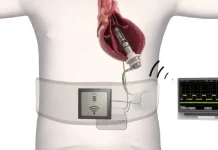PlaqueIQ is a non-invasive software that can objectively quantify and classify plaque morphology based on ground-truth histology, and is designed to give physicians new, clinically validated information to help stratify patients and inform patient-specific treatment pathways.
“The fact that low-risk, asymptomatic patients represent such a large portion of the population means that even a small fraction of them account for a substantial number of myocardial infarctions,” said Amir Ahmadi (Icahn School of Medicine at Mount Sinai and Mount Sinai Fuster Heart Hospital at Morningside, New York, USA). “It’s time to shift our focus from merely estimating risk and treating risk of MI to directly visualising and treating the disease itself by looking at the coronary arteries.
Related: FDA clears Surmodics’ Pounce XL thrombectomy system
“I believe that PlaqueIQ will enable physicians to better ‘see’ the disease—specifically plaque quantity and type—so that we can treat patients with greater precision and in personalised manner, improve their quality of life, and ultimately prevent myocardial infarction (MI) and stroke more effectively.”
PlaqueIQ utilises first-line diagnostic coronary computed tomography angiography (CCTA) and develops reports to help physicians virtually “see” plaque at the vessel level, Elucid says in a press release. The software is able to non-invasively quantify and characterise non-calcified plaque and its components such as lipid-rich necrotic core (LRNC), giving potential insights into high-risk plaques that are key drivers of risk of heart attack and stroke.
“PlaqueIQ’s underpinnings in histology is a novel approach to the field of non-invasive coronary plaque classification,” said Mark Rabbat (Loyola University Chicago, Chicago, USA). “Armed with additional data on vulnerable plaque components, we can make more informed treatment decisions on drug therapy selection or the need to send the patient to the cath lab. I believe plaque quantification has the potential to greatly improve outcomes for patients while providing tremendous savings to the healthcare system.”
Physicians send patient images to Elucid which applies image-restoration algorithms to the file to mitigate motion and calcium blooming artifacts. Analysts segment the data creating a 3D model of the patient’s coronary arteries. The software then identifies, classifies and quantifies tissue structure and composition.
“Elucid’s mission is to commercialise proven technologies that can make a meaningful difference in the prevalence of heart attack and stroke, and the FDA clearance of PlaqueIQ is a huge step forward towards that goal,” says Kelly Huang, CEO of Elucid. “We know that plaque is the key contributor to these devastating events, and, specifically, high-risk plaque components, but you can’t treat what you can’t see. With PlaqueIQ, physicians can gain new and insightful histology-based information to help better understand plaque composition and get ahead of the disease.”
Elucid is currently performing beta testing on PlaqueIQ and anticipates making the software available for limited release later in Q4 2024. The company is also pursuing an indication for non-invasive measurement of fractional flow reserve (FFRCT), derived from its PlaqueIQ technology, to measure coronary blockages and the extent of ischaemia.






